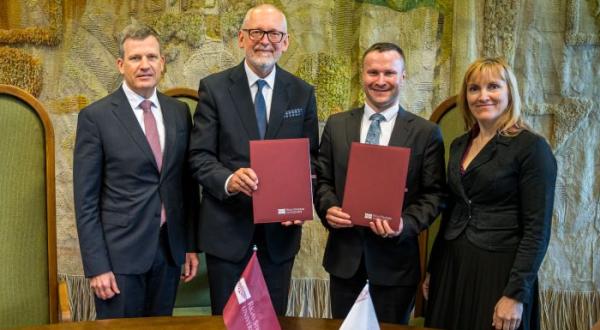RSU History Museum opens new exhibition on the historical turn of our University
An exhibition created by the Rīga Stradiņš University (RSU) History Museum will be on display in the glass cases by the RSU Great Hall at 16 Dzirciema iela from March 27 to July 19 - HISTORIC TURN; How the First World Congress of Latvian Physicians (1989) influenced the development of RSU.
In the second half of the 1980s, Latvia, Lithuania, and Estonia were at the beginning of the Singing Revolution – an effort to regain independence from Soviet occupation. In Latvia, it was also called the Third Awakening.
In 1987, several protest rallies against USSR totalitarianism were held next to the Freedom Monument in Riga. In 1988, significant events took place that contributed to the revival of the Latvian nation, and the strengthening of the Latvian language and culture: the Baltica festival (10 – 18 July 1988), the rehabilitation of the Latvian flag in the Mežaparks district of Riga (16 July 1988) and the opening concert of the founding congress of the Popular Front of Latvia (07 October 1988).
One of the central events in the following year was the First World Congress of Latvian Physicians. The congress was held in Riga from June 18 to 27, 1989 and brought together nearly 6,000 physicians, nurses, and medical professionals from Latvia and the Western world. One of the organisers, Dr Bertrams Zariņš from the US, described the congress as follows:
‘This was a unique event in occupied Latvia and a historic step towards Latvia's freedom.’
Many lecturers from the Rīga Medical Institute (the name that Rīga Stradiņš University held from 1950 to 1990) participated in the congress’ many symposia and plenary sessions, primarily as physicians. Equally important was the exchange of ideas on how to train prospective medical and healthcare professionals in the future. Thanks to the congress, the following topics and needs were addressed:
- The organisation of a multi-year higher education cycle for training head nurses;
- The training of dental hygienists to implement primary dental care in order to reduce dental caries and periodontal disease;
- The training of physiotherapists for the needs of outpatient, regional, and district hospitals;
- The training of general practitioners using the accumulated experience gained from medical professionals from abroad.
The third paragraph of the Congress resolution states: ‘To recognise medical education and professional development as important forms of international cooperation.’
The Popular Front of Latvia organised a significant event related to the Congress on 24 June at RMI. During this event, almost every department of the institute established contacts with their peers from abroad. The event provided an opportunity to get acquainted with the level of education and medicine in the West and bring this experience back to RMI. Valuable books, medical equipment, and other forms of humanitarian aid also began to flow to Latvia, which contributed to the development of the University.
Over the next 10-12 years, RMI (which was renamed the Medical Academy of Latvia in 1990 on the recommendation of its Western counterparts), with its four faculties (Medicine, Paediatrics, Dentistry, and Pharmacy), grew into a fully-fledged and modern research university – the RSU that we know today.
Related news
 Four-way cooperation agreement signed to elevate health and sports science researchKonsolidācija, For Students, Development, For RSU Employees
Four-way cooperation agreement signed to elevate health and sports science researchKonsolidācija, For Students, Development, For RSU Employees


